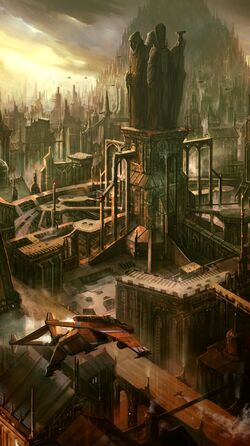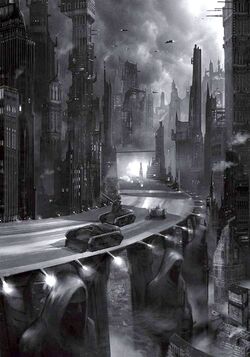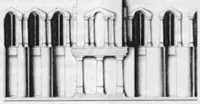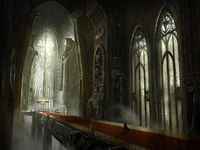
An Imperial mausoleum overlooking a Hive City, a typical example of Imperial Gothic architecture
Imperial Architecture refers to the unique style of design and construction of the various cities, manufactoria, refinery complexes, habitations, religious spaces and similar groups of buildings that are commonplace amongst the developed human-settled worlds of the Imperium of Man.
For ten thousand standard years the Imperium of Man has stretched across the galaxy, conquering world upon world, settling them in the name of the Emperor. Upon every planet settled by Mankind are built vast sprawling cities, each one a metropolis teeming with Imperial citizens. The typical characteristics of Imperial architecture include pointed arches, ribbed vaults and flying buttresses.
This so-called "Imperial Gothic" style represents the underlying design ethic of many of the Ecclesiarchy's great cathedrals, abbeys and churches found across the various worlds of the Imperium and is also the preferred style of many Sanctums Imperialis, palaces, town halls, guild halls, universities and to a less prominent extent even private dwellings, such as dormatories and personal quarters.
The Gothic style is also utilised on the great void-faring vessels of the Imperial Navy, Imperial void stations, star forts and the Imperial merchant fleet. It is in the great churches and cathedrals and in a number of the grander civic buildings that the Imperial Gothic style is expressed most powerfully, its characteristics lending themselves to appeal to the emotions and devotion in the God-Emperor, whether springing from faith or from civic pride.
History[]

Example of Imperial Gothic architecture in the Imperial capital city of the Promethium-rich planet of Dheneb -- Dheneb Capitalis
Thanks to the Standard Template Construct, buildings of several common types are constructed on most Imperial worlds using locally available materials. Using the designs offered by the Standard Template Construct means that the appearance of a building is determined by its function rather than the materials of which it is constructed.
According to the resource base of the planet in question, this can be stone, brick, wood, coral, volcanic ash, compacted inorganic waste or any of a hundred other materials. Thus, buildings of more or less identical appearance may be found throughout the Imperium, regardless of all considerations other than function.
Since the time of the Great Crusade, Terran engineers aboard Imperial Expeditionary Fleets were exported to all of the new worlds brought into Imperial Compliance by the Administratum. As many of these newly unified worlds' populations boomed enormously under the shelter of the Imperium, hive cities designed by those Terran engineers (utilising STC patterns) were built on even the most isolated or backwater planets, even Death Worlds such as Caliban and Catachan. Though for the most part the architecture remains relatively unchanged and easily recognisable, each world tends to incorporate their own unique style based on local influences.
Components of Imperial Civic Architecture[]
- Administratum - The complex organisation of the Adeptus Administratum is responsible for the administration of the whole of the Imperium; it manage over a million inhabited worlds. Planetary government buildings, record offices, taxation centres and many more are controlled by the Administratum. They are usually distinguished by the sign of the Imperial Aquila over the main door. Many bloody assaults and valiant defences have taken place in and around urban and planetary government buildings; they are natural command points, and the fall of the Administratum normally indicates the fall of the city. This building is often an attacker's primary target.
- Auditorium - Most Imperial cities have at least one auditorium, where the populace assemble at great rallies organised by the Administratum and the Inquisition. A visiting dignitary, such as an Inquisitor or a Space Marine commander, will often be requested to lead such a rally. It is common practise to use the main auditorium -- if it still stands -- to announce the "liberation" of a city by one side or the other.
- Castra Exercitus - According to the provisions of the Codex Exercitus, every Imperial world has a duty to raise and maintain its own Planetary Defence Force. Additionally, each city or world forms part of a precinct where Imperial laws are enforced by the Judges of the Adeptus Arbites. One or more barracks will be found in most Imperial cities, providing accommodation, training areas and armouries for the forces they house. Much fighting has centred around these strongholds.
- Chapel - Chapels are found throughout the Imperium, and the illustration above includes a typical example from an Imperial world of medieval or higher technology. On many worlds which fell to the forces of the Warmaster Horus during the Horus Heresy where the unofficial cults of the Lectitio Divinitatus had established chapels to the God-Emperor, these were desecrated and torn down; on some Traitor worlds they had even been turned over to the Feral World cults favoured by the Warmaster and his followers. In such cases, during the Great Scouring, the newly-created Inquisition normally demanded the chapel's complete destruction.
- Cellarion - No world is an island within the Imperium; each gains something from the rest of the galaxy, and each must pay its way. The worlds of the Imperium provide foodstuffs, machinery, minerals and many other things according to their resources. Few Imperial cities are without vast warehouse complexes where these goods are collected ready for shipment to other areas and worlds, and where incoming goods are placed ready for distribution.
- Censorium - Countless clerks and officials labour on a million worlds for the Administratum, most of them confined to dark offices in grim, towering administrative blocks. These buildings house vast quantities of information on their worlds; population, economy, levels of production and taxation, resources, industrial and agricultural quotas -- the whole of the world is recorded, filed, indexed and updated by an army of bureaucrats. The valuable data in a Censorium can make it a prime target.
- Generatorium - A city or industrial complex requires vast quantities of energy, and power supplies are a favourite target for attacking forces. The nature of a generator will vary from world to world. Fertile planets often use organic or fossil fuel, while fusion grids and Plasma Reactors are common on industrialised worlds. Solar generators and geothermal energy are also used where local conditions permit. These power sources, and the secrets of their operation, are jealously guarded by the Adeptus Mechanicus.
- Genetorium - Most planets in the Imperium maintain a gene-pool of plant and animal species for terraforming, agriculture, resource management and other purposes. Native species are studied with a view to assessing their usefulness elsewhere, and introduced species are bio-engineered to adapt them for use in local conditions. The Genetors of the Adeptus Mechanicus who run these establishments also monitor the genetic purity of the planet's population, and cooperate with the Inquisition in their task of rooting out mutation and other undesirable traits.
- Librarium - During the terrible wars of the Age of Strife, untold quantities of knowledge were lost, and preserving that which remains has become a holy task shared by the Administratum and the Adeptus Mechanicus. In many of the larger cities of the more advanced Imperial worlds, an imposing Librarium building will house thousands of books and records, and make them available to those Imperial servants whose rank entitles them to access.
- Manufactorium - Although much technology was lost during the fifteen centuries of the Age of Strife, the Imperium is by no means technically backward. Industrial complexes across the galaxy produce billions of items, from clothing to plasma bombs. All of these installations are closely controlled by the Administratum and the Adeptus Mechanicus, and it is not uncommon for the workers in a factory to be completely unaware of the end-product of their labours. The occupation or destruction of the manufactorium or industrial complex can deny precious resources to the enemy.
- Mausoleum - For the vast bulk of the citizens of the Imperium, death is not the end of their service to the Emperor. They are quickly forgotten by everyone except the record-keepers of the Administratum and their bodies are recycled into foodstuffs, fertilisers, and other useful products. More prominent members of society may receive the honour of entombment in an Imperial mausoleum, where the masses may read of their deeds and be inspired by their example. With its halls of entombed heroes, a Mausoleum can become the focus of a fanatical defence, and its destruction can deal a severe blow to the defenders' morale.
- Residential - The population of the Imperium is vast, and only the Administratum has the means to begin to estimate it. The bulk of this population lives in cities, ranging from the huge complexes of the Hive Worlds to the smaller garden cities of the more advanced agricultural worlds and the grim tenements of the Industrial Worlds. While worlds and cities may differ, the residential blocks follow a limited number of standard patterns laid down by the Standard Template Construct. Living space in the cities varies widely, according to wealth and social standing. Most people live in residential blocks of one kind or another, but the living space permitted to an individual can range from a spacious luxury apartment to a cramped and filthy cubby-hole with barely room to turn round. According to the type of world on which it is found and the status of its occupants, a residential block can house a few dozen or several thousand.
Life in an Imperial City[]

Most cities in the Imperium are dark, brooding places where the countless subjects of the God-Emperor eke out a meagre living. Vast stinking factories filled with grinding machines cause the bones to shudder, while blackened chimneys vomit forth thick, dark clouds of toxic smoke, blocking out the sun itself.
Every citizen lives a life of perpetual service, slaving away at back-breaking and mind-numbing tasks for twenty solar hours a day, before dragging their exhausted, labour-wracked bodies beneath their benches to snatch a few solar hours of fitful sleep.
The spires of the wealthy reach high above the clouds of filth and are filled with such opulence as can scarcely be comprehended by those far below. In these sanctuaries of the privileged, nothing is wanted for and the elite live in ignorance and indifference to the suffering in the streets and factories beneath them.
For every city in the Imperium that might be called typical, there are others that defy the senses and beggar belief. Some of these cities stretch kilometres into the sky, towering buttresses of battered stone and rusting metal, vast hives of human life and inhuman suffering. Others sink hundreds of metres below the world's surface, the populace dwelling in vast caves of rock and ice, while others still float on great lakes of water, acid or lava.
There are cities devoted entirely to the worship of the God-Emperor, where the Cult Imperialis reigns supreme and the rooftops echo constantly to the sound of a million voices raised to hymns and prayer. Hosts of pilgrims gather daily, shuffling on blistered feet down dusty streets dedicated to warriors and Imperial Saints long dead, the city illuminated by the light of a billion votive candles, each a vain prayer to an unseen god.
There are cities given to the administration of Humanity's innumerable population and infinite resources, every inhabitant enslaved to routine and process, every last round of ammunition and grain of wheat accounted for by stone-faced scribes. There, the true worth of human life is established by workers jaded by the never-ending monotony of their assigned chore. For most, the cities of the Imperium are merciless and cruel places, where all hope is lost and only mindless subservience remains.
Sources[]
- Space Marine (Game) (1st Edition) by Jervis Johnson and Rick Priestly, "Imperial Architecture," pp. 14-15
- Warhammer 40,000: Cities of Death (5th Edition) by Andy Hoare, pp. 2, 4-7, 20-22, 54-55















